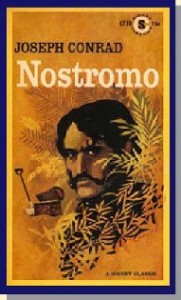
My principal authority for the history of Costaguana is, of course, my venerated friend, the late Don Jose Avellanos, Minister to the Courts of England and Spain, etc., etc., in his impartial and eloquent “History of Fifty Years of Misrule.” That work was never published–the reader will discover why–and I am in fact the only person in the world possessed of its contents. I have mastered them in not a few hours of earnest meditation, and I hope that my accuracy will be trusted.
–Nostromo, by Joseph Conrad
Joseph Conrad’s fictional book “History of Fifty Years of Misrule” is an example of one of the best quest Macguffins ever.
People sometimes underrate the Macguffin (a quest object that the fiction or RPG characters care about more than the viewers or players). A good macguffin does more than act as bait for heroes: it can also generate adversaries.
For instance, a James-Bond-type Macguffin, like the code to a satellite-mounted laser, suggests the types of people who would want it: various governments and terrorist groups. A fantasy macguffin that confers mystic power, like the One Ring, suggests various evil overlords who would like to wield it, misguided people who would like to use it for good, and stalwart folk who wish to destroy it.
Consider the idea of a book called “History of Fifty Years of Misrule”, a memoir written by an honorable, disillusioned politician during a period of petty wars and tragically wasted opportunities. It might contain
stories of political outrage; friends, relatives, ruined, imprisoned, killed in the battles of senseless civil wars, barbarously executed in ferocious proscriptions, as though the government of the country had been a struggle of lust between bands of absurd devils let loose upon the land with sabres and uniforms and grandiloquent phrases.
It’s part of the fruitful “scandalous memoir Macguffin” tradition which I often associate with P. G. Wodehouse (although this one is a lot darker). Like any good Macguffin, this one suggests its own adversaries: throw the manuscript in the PCs’ lap, and they’ll inevitably clash with members of the following groups:
its targets, the greedy, treasonous, or stupid people who don’t want its secrets revealed;
its targets’ enemies, who want them punished. Some are motivated by justice, and some by ambition.
scoundrels who want the document, to use as blackmail, or to publish in the name of widespread chaos.
the author’s friends and relatives, who want it suppressed: if it’s published, the author and his family will accumulate many enemies.
If the PCs end up with such a book, they’ll be the targets of a lot of schemes. The easiest thing they can do is to destroy it right away. Don’t make that an easy decision, though. The book might be worth a lot of money to a crime boss. The book might clear the name of a banished paladin whose daughter is asking the PCs for help. Furthermore, the book may hint that the Sword that Defends the Kingdom might not have been destroyed after all, but might be hidden in the treasure vaults of one of a cabal of corrupt nobles.
The strength of the memoir as a plot device, I think, is that it allows the PCs to predict who’s going to come after them. You don’t need to take pains to introduce the above factions. The PCs can ask questions: “Whose reputation would be damaged by the book? Who would pay for this information?” It allows the PCs a lot of freedom in writing their own plot in a sort of political sandbox adventure. Are the PCs going to right wrongs and punish evildoers? Play villains against each other and milk them all for cash? If the PCs are proactive, the plot is up to them. On the other hand, if they lag, there’s plenty of people chasing them to keep things moving.
Here’s a fun trick: if PCs read the book, describe its contents based on the alignment of the PC. To a lawful good character, it is a depressing work describing the kingdom’s squandered chances. To a lawful evil character, describe it as a fascinating collection of blackmail fodder. To a chaotic neutral character, say it’s a hilarious political farce, especially funny because it’s all true.
“History of Fifty Years of Misrule” didn’t get the star treatment in Nostromo, because that novel already had another Macguffin: a shipment of silver from a contested mine. That’s also a good plot-driver: I might post about that one later.
 Last week I mentioned a bizarre trapped chest from a Sax Rohmer novel. Here’s another weird chest, from The Star Venturers by pulp-sci-fi author Kenneth Bulmer:
Last week I mentioned a bizarre trapped chest from a Sax Rohmer novel. Here’s another weird chest, from The Star Venturers by pulp-sci-fi author Kenneth Bulmer:









